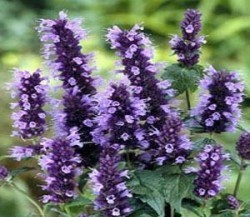Cusick's Giant Hyssop
(Agastache cusickii)

Description
Agastache cusickii is a species of flowering plant in the mint family known by the common name Cusick's giant hyssop. It is native to the northwestern United States from eastern Oregon and central Nevada to Idaho and Montana. This perennial herb grows 10 to 20 centimeters tall from a woody taproot and caudex. Some of the stems spread horizontally underground. It has leaves covered in fine hairs and the fruits are nutlets. The spikelike inflorescence bears flowers with purple-tipped sepals and white corollas each about a centimeter long with protruding stamens. Blooming occurs in June through August. This plant grows in sagebrush and alpine ecosystems. It grows in dry, rocky mountain habitat such as talus slopes. In Nevada it grows in limber pine and pinyon-juniper woodland habitat. On Steens Mountain in Oregon it has been observed among western juniper (Juniperus occidentalis), curlleaf mountain-mahogany (Cercocarpus ledifolius), and quaking aspen (Populus tremuloides). In the Tendoy Mountains of Montana it is associated with big sagebrush (Artemisia tridentata) and Indian ricegrass (Oryzopsis hymenoides) on limestone talus. Agastache is a genus of aromatic flowering herbaceous perennial plants in the family Lamiaceae. It contains 22 species, mainly native to North America, one species native to eastern Asia. The common names of the species are a variety of fairly ambiguous and confusing "hyssops" and "mints"; as a whole the genus is known as giant hyssops or hummingbird mints. Most species are very upright, 0.5-3 m tall, with stiff, angular stems clothed in toothed-edged, lance shaped leaves ranging from 1-15 cm long and 0.5-11 cm broad depending on the species. Upright spikes of tubular, two-lipped flowers develop at the stem tips in summer. The flowers are usually white, pink, mauve, or purple, with the bracts that back the flowers being of the same or a slightly contrasting color. Agastache derives from the Ancient Greek words ἄγαν (ágan) "very much" and στάχυς (stákhus) "ear of grain", describing the flower spikes. The genus was established in 1762 by Jan Frederik Gronovius in the second edition of his controversial Flora Virginica, based on the specimens and notes of John Clayton. It is a member of subfamily Nepetoideae, which contains a large proportion of the world's aromatic culinary herbs. Within its subfamily, it belongs to the mint tribe (Mentheae), and therein to the catmint subtribe (Nepetinae).
Taxonomic tree:







